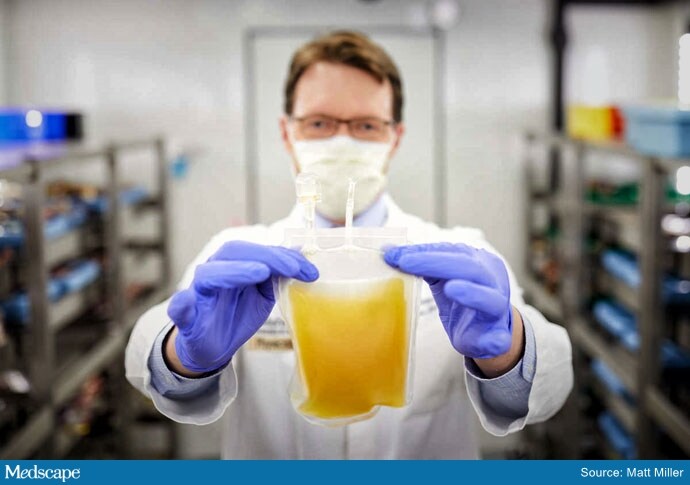Editor’s note: Find the latest COVID-19 news and guidance in Medscape’s Coronavirus Resource Center.

Dr Jeffrey P. Henderson, from Washington University School of Medicine in St. Louis, holds a bag of convalescent plasma.
A strong case for the routine use of convalescent plasma for patients with blood cancer who are hospitalized with COVID-19 is made by the results from a new study published in JAMA Oncology.
Patients with blood cancer are at a particularly high risk for severe complications from COVID because the cancer and its treatment short circuit patients’ ability to make antibodies to fight off infection. Convalescent plasma, obtained from people who have had COVID-19 and have recovered, provides such patients with antibodies.
The approach was useful during the Spanish flu pandemic in 1918, as well as during the more recent SARS and MERS coronavirus pandemics.
The team conducted the study after “hearing physicians around the country report remarkable clinical improvements,” said investigator Jeffrey Henderson, MD, PhD, associate professor of medicine and molecular microbiology at Washington University in St. Louis, St. Louis, Missouri, in a statement.
“I have seen one of my own patients with blood cancer quickly improve after receiving convalescent plasma. Similar stories…suggested that a formal study” was in order, he said.
The investigators analyzed data from 70 institutions in the United States that were participating in the COVID-19 and Cancer Consortium registry.
They pulled the records of 143 patients with hematologic malignancies who received convalescent plasma while hospitalized for COVID-19, and they compared the 30-day all-cause mortality with 823 hospitalized patients who did not receive the plasma.
Among the plasma recipients, 19 patients (13.3%) died within 30 days of being diagnosed with COVID-19, vs 204 (24.8%) in the control group, which translated to a 40% reduction in the risk for death after controlling for confounders. After propensity matching, the reduction in the risk for death was 48%.
In an analysis that was limited to 388 patients who were admitted to the intensive care unit for respiratory and other complications, 30-day mortality was 15.8% in the plasma group, vs 46.9% in the control patients, which translated to a 40% drop in risk on propensity matching.
Among 227 patients who were placed on ventilators, 30-day mortality was 17.8% with convalescent plasma, vs 53.3% without, a 68% reduction.
“As with any observational study, causality cannot be inferred from these findings, but rather these findings can be viewed as contributing to the accumulating evidence regarding survival benefit with convalescent plasma treatment in patients with COVID-19 illness,” said investigators led by Michael Thompson, MD, PhD, a medical oncologist and hematologist at Advocate Aurora Health in Milwaukee, Wisconsin.
“Our findings, along with other similar cases not in this database, support using convalescent plasma to improve survival in these patients,” he said in a press release.
Bridging the Gap
The findings fill “a major knowledge gap, as most studies on convalescent plasma” include few patients with cancer, comment Gregory Calip, PharmD, PhD, a hematology/oncology epidemiologist and biostatistician at Flatiron Health, in New York City, and colleagues in an accompanying editorial.
Despite the limitations of retrospective data, “the consistent directionality and significance of the effect estimates reported is encouraging. Determining a causal treatment effect of convalescent plasma will ultimately require an appropriately designed clinical trial,” the editorialists write.
Plasma Patients Were Sicker
Among the study limits, it’s not known how many transfusions of convalescent plasma each individual received, exactly when they received transfusions during their hospitalization, and how the transfusions were timed with respect to the patients’ cancer treatments. Another unknown is the antibody levels of the transfused plasma.
However, convalescent plasma recipients were considerably sicker than control patients, with more sepsis and respiratory complications. They were also more likely to have chronic lymphocytic leukemia. In such patients, COVID-19 is associated with a particularly bad prognosis. These patients are more likely to receive corticosteroids and the antiviral remdesivir.
There was a worry that thrombosis and acute kidney failure would be more prevalent among the plasma group because of the transfusions, but that did not turn out to be the case. On the other hand, the slightly higher rate of heart failure in the plasma group (7% vs <3.5% on propensity matching), probably from volume overload, does bear watching, the investigators say.
The patients were treated from March 2020 to January 2021. It’s likely most of the patients received plasma through the US Food and Drug Administration’s Expanded Access Program and subsequent emergency use authorization.
The mean age of the patients was 65 years, and slightly more than half were men. Multiple myeloma was the most common cancer diagnosis, accounting for about 20% of cases.
The study was funded by the National Institutes of Health and others. Several investigators have disclosed ties to industry, but none were related to this study. The editorialists were employed by Flatiron Health, which is owned by Roche.
JAMA Oncol. Published online June 17, 2021. Full test, Editorial
M. Alexander Otto is a physician assistant with a master’s degree in medical science, and an award-winning medical journalist who has worked forseveral major news outlets before joining Medscape. Email: [email protected].
For more news, follow Medscape on Facebook, Twitter, Instagram, and YouTube.
Source: Read Full Article